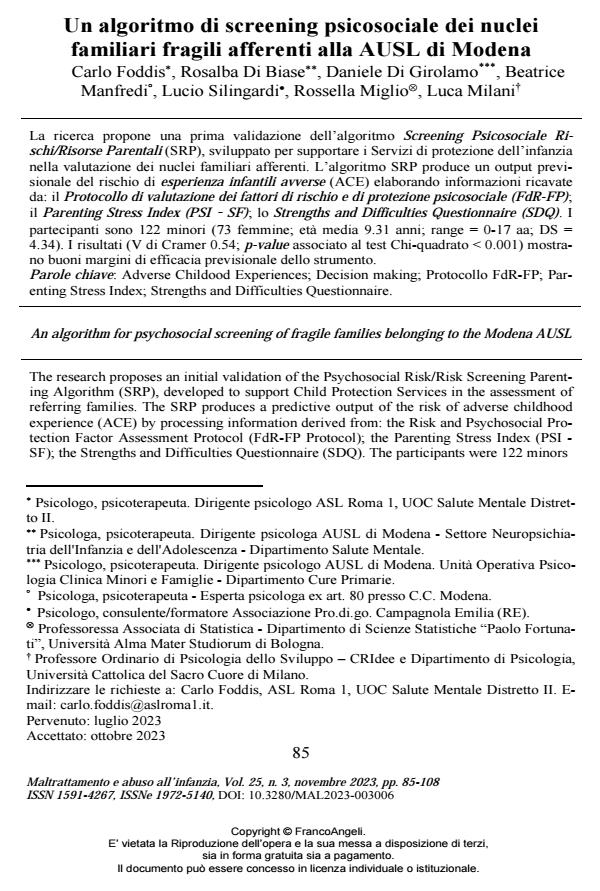Un algoritmo di screening psicosociale dei nuclei familiari fragili afferenti alla AUSL di Modena
Titolo Rivista MALTRATTAMENTO E ABUSO ALL’INFANZIA
Autori/Curatori Carlo Foddis, Rosalba Di Biase, Daniele Di Girolamo, Beatrice Manfredi, Lucio Silingardi, Rossella Miglio, Luca Milani
Anno di pubblicazione 2024 Fascicolo 2023/3
Lingua Italiano Numero pagine 24 P. 85-108 Dimensione file 358 KB
DOI 10.3280/MAL2023-003006
Il DOI è il codice a barre della proprietà intellettuale: per saperne di più
clicca qui
Qui sotto puoi vedere in anteprima la prima pagina di questo articolo.
Se questo articolo ti interessa, lo puoi acquistare (e scaricare in formato pdf) seguendo le facili indicazioni per acquistare il download credit. Acquista Download Credits per scaricare questo Articolo in formato PDF

FrancoAngeli è membro della Publishers International Linking Association, Inc (PILA)associazione indipendente e non profit per facilitare (attraverso i servizi tecnologici implementati da CrossRef.org) l’accesso degli studiosi ai contenuti digitali nelle pubblicazioni professionali e scientifiche
La ricerca propone una prima validazione dell’algoritmo Screening Psicosociale Ri-schi/Risorse Parentali (SRP), sviluppato per supportare i Servizi di protezione dell’infanzia nella valutazione dei nuclei familiari afferenti. L’algoritmo SRP produce un output previsio-nale del rischio di esperienza infantili avverse (ACE) elaborando informazioni ricavate da: il Protocollo di valutazione dei fattori di rischio e di protezione psicosociale (FdR-FP); il Pa-renting Stress Index (PSI – SF); lo Strengths and Difficulties Questionnaire (SDQ). I partecipanti sono 122 minori (73 femmine; età media 9.31 anni; range = 0-17 aa; DS = 4.34). I risultati (V di Cramer 0.54; p-value associato al test Chi-quadrato < 0.001) mostrano buoni margini di efficacia previsionale dello strumento.
Parole chiave:Adverse Childood Experiences; Decision making; Protocollo FdR-FP; Parent-ing Stress Index; Strengths and Difficulties Questionnaire.
- An investigation into the quality of services provided by a psychiatric day center in the representations of the actors involved Carlo Foddis, Giulia Sarnataro, Noemi Carminati, Valeria Di Bartolomei, Natalia Palermo, Eleonora Amicosante, Andrea Colacicco, Chiara Mesoraca, Alessandro Grispini, in RIVISTA DI PSICOLOGIA CLINICA 2/2025 pp.71
DOI: 10.3280/rpc2-2024oa16645
Carlo Foddis, Rosalba Di Biase, Daniele Di Girolamo, Beatrice Manfredi, Lucio Silingardi, Rossella Miglio, Luca Milani, Un algoritmo di screening psicosociale dei nuclei familiari fragili afferenti alla AUSL di Modena in "MALTRATTAMENTO E ABUSO ALL’INFANZIA" 3/2023, pp 85-108, DOI: 10.3280/MAL2023-003006